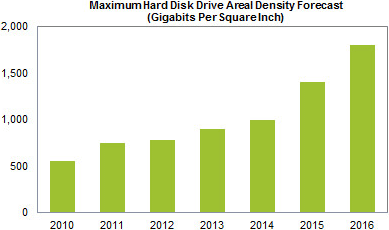Hard Disk Drives’ Densities to Double by 2016
Peter Donnell / 12 years ago

Maximum areal densities in hard disk drives (HDD) are expected to more than double during the five-year period from 2011 to 2016, spurring continued growth for HDDs in storage-intensive applications such as video and audio systems, according to an IHS iSuppli market research firm.
5TB Hard Drives on Track for This Year
HDD areal densities measuring data-storage capacities are projected to climb to a maximum 1800Gb/inch2 per platter by 2016, up from 744Gb/inch2 in 2011, as shown in the figure below. This means that from 2011 to 2016, the five-year compound annual growth rate (CAGR) for HDD areal densities will be equivalent to 19%. For this year, HDD areal densities are estimated to reach 780Gb/inch2 per platter, and then rise to 900Gb/inch2 next year. At present the highest areal density it around 625Gb/inch2.

“The rise in areal density will pave the way for continued growth of the HDD industry. Densities will double during the next five years, despite technical difficulties associated with the perpendicular magnetic recording (PMR) technology now used to create higher-areal-density hard disks. In particular, growth opportunities will lie in applications associated with mass enterprise storage requirements, gaming, and in digital video recorders (DVRs) where massive capacity is required to store high-definition video,” said Fang Zhang, analyst for storage systems at IHS.
At present the highest areal density it around 625Gb/inch2. Only a year earlier in 2010, the highest areal density that could be achieved for a platter amounted to 550Gb/inch2. With the advancements of platter and HDD technologies, with the 1TB per-platter milestone already reached, 5TB hard disk drives using five platters could be available on the market later this year.
All HDD manufacturers currently use PMR technology for existing HDD products, but the industry consensus is that existing PMR technology has two to three generations left before reaching its areal density limit at about 1Tb/inch2. In fact, despite the solid five-year CAGR for higher-density HDDs, growth rates could have been much higher were it not for PMR technology nearing its limit.
Nonetheless, new developments are on the way. For instance, Seagate in March announced it had achieved in its research lab 1Tb/inch2of areal density – 30% higher than what could be achieved through PMR technology – by using heat-assisted magnetic recording (HAMR) technology.
HAMR technology is likely to lead the way in creating next-generation HDDs, even though satisfactory costs via HAMR comparable to those of PMR have yet to be seen. In theory, however, advanced technologies like HAMR could extend HDD areal density to a range spanning 5Tb/inch2 to 10Tb/inch2.
The highest capacity for 3.5″ HDDs could then reach 30TB to 60TB, while the smaller and thinner 2.5″ HDDs used in increasingly popular thinner notebooks could reach 10TB to 20TB.
Such lofty heights represent approximately 10 to 20 times the capacity of current drives, with the new theoretical levels having a capacity equivalent to those of conventional small and medium business (SMB) storage systems currently on the market, marking a major leap in electronic storage for more common, non-enterprise uses.
Source: Xbitlabs



















